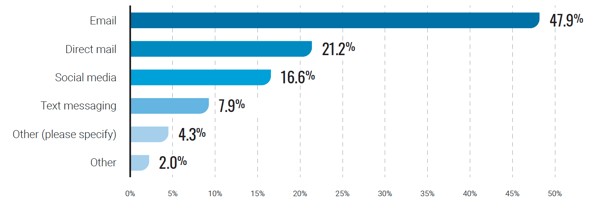
How to Get Your Email Delivered to Your Donors’ Inboxes
Email continues to be a top revenue-driving channel for marketers, even compared to emerging channels like social media and influencer marketing. The volume of email users continues to climb, and brands are leveraging this channel to create quality connections with consumers.
For nonprofits, the impact of email marketing is measurable, and reliable. In fact, according to Data Axle’s recent Nonprofit Email Deliverability Report, email is by far the most preferred communication channel by donors.
How would you most prefer nonprofits to communicate with you?

Beyond being a preferred communication channel, email remains one of the top digital-revenue driving channels as well. M+R reported in their 2021 benchmarks that for every 1,000 fundraising messages sent in 2020, nonprofits raised $78; a 35% increase over 2019. As we see digital giving continue to rise (21% increase in 2020), email will continue to play a role in multichannel marketing, and revenue results.
But before a supporter can read or respond to an email, it must first get delivered, and make its way to the inbox.

Email Delivery vs. Inbox Placement
- Delivery Rate: Delivery rate is a measure of a sender’s emails being successfully delivered to an internet service provider (ISP). If an email service provider (ESP) attempts to deliver an email to an ISP and the ISP accepts the email without rejecting it (which would be considered a bounce), the ESP considers the email delivered.
- Inbox Placement: Inbox placement is a measure of how often email is delivered to the subscribers’ inbox, rather than being held or placed in a spam folder. It is a far more useful metric than delivery rate and a better indicator of how much email is being seen by subscribers.
While Return Path estimates that only 82% of email campaigns in the U.S. make it to the inbox, Data Axle’s Nonprofit Email Deliverability Report showed some stark realities related to nonprofit inbox placement.
- 1 in 5 nonprofit emails did NOT reach the inbox in Q1 2021.
- 1 in 6 nonprofit emails did NOT reach their intended recipients in Q1 2021.
- Nearly 1 in 4 nonprofit emails were DELETED without being read by the recipient.
Well, that sounds bad. What can I do to improve my nonprofit’s delivery rate and inbox placement?
The good news is that marketers can influence not only their email deliverability, but also inbox placement. Making small changes across many aspects of your email program, combined with a smart use of technology and third-party partners, can make a big impact on the inbox. Here are the three main variables you can influence to positively impact deliverability and inbox placement.
1. Tech and Infrastructure
Using a best-in-class ESP will only get you so far. Technology and data hygiene are important factors in the deliverability game. Here are the four pieces of technology behind email deliverability:
- IP warm-up: When migrating to a new platform or onboarding new send IPs, make sure to slowly warm them up so as not to trigger ISPs and impact your delivery.
- Domain verification: Incorporate two-factor authentication to ensure your “send from” domain is trusted and established by various ISPs.
- Sender reputation: Many ISPs apply sender “scores” to marketers based on a combination of factors including email volume, spam/complaint rates, bounce/unsubscribe rates, and engagement rates. Monitor these metrics and shift course if you’re seeing spikes or concerning trends.
- Quality Data & Email Hygiene: When appending or collecting new email addresses, be sure you’re validating those addresses at the point of acquisition. Growing your file with bad quality email addresses will negatively impact your sender reputation and delivery rates. Perform regular email NCOA and hygiene to ensure you’re refreshing and reaching constituents.
2. Creative, Content, and Code
- Clean HTML code is a must-have to land in inboxes and bypass spam filters. Be sure to design for mobile users as well. Extraneous scripts or code snippets can cause red flags and land you in spam jail if not caught.
- Subject lines can trigger spam filters and directly correlate to open rates. Keep an eye on trends across the email landscape as well as response on your own file. Typically, personalization and shorter subject lines draw more opens, but in the busy times of year (such as end of year), being creative can help you stand out from the competition!
- Images and formatting play a role as well. Make sure images are sized correctly (for all devices) and don’t take too much time to load. Not only will that help the code render properly, but it will create a better user experience for the recipients.
3. Relationships and Reach
- Engagement is one of the most impactful aspects affecting your sender score across ISPs. The more your audience engages with you in a positive way, the more emails will hit inboxes.
- Segmentation: Be sure to strategically send messages to your most loyal constituents first, and suppress those who are consistently inactive. That approach will allow more messages to reach your lesser-engaged audience segments.
- Volume: Make an effort to have a consistent send cadence and volume, which also impacts your audience engagement.
- ISP Relationships: Partnering with an email delivery expert like Data Axle or Validity can help proactively manage relationships on behalf of your brand with key ISPs like Google, Yahoo, AOL, and Microsoft.
There is no time like the present to improve your email deliverability and inbox placement. As you head into the busiest fundraising season of the year, make sure your email files are clean, supporters are appropriately segmented, your creative is compelling, and your code is clean.
